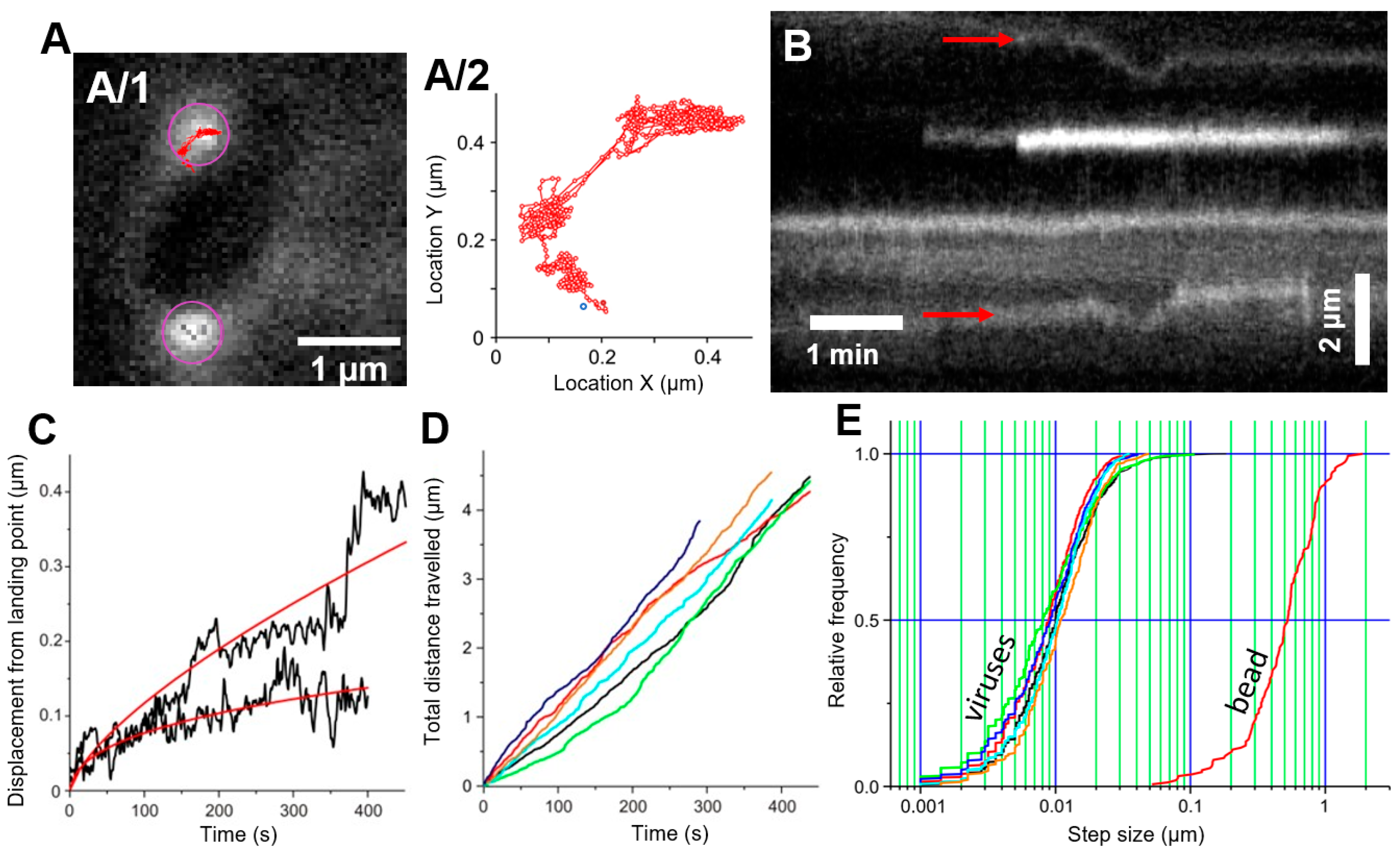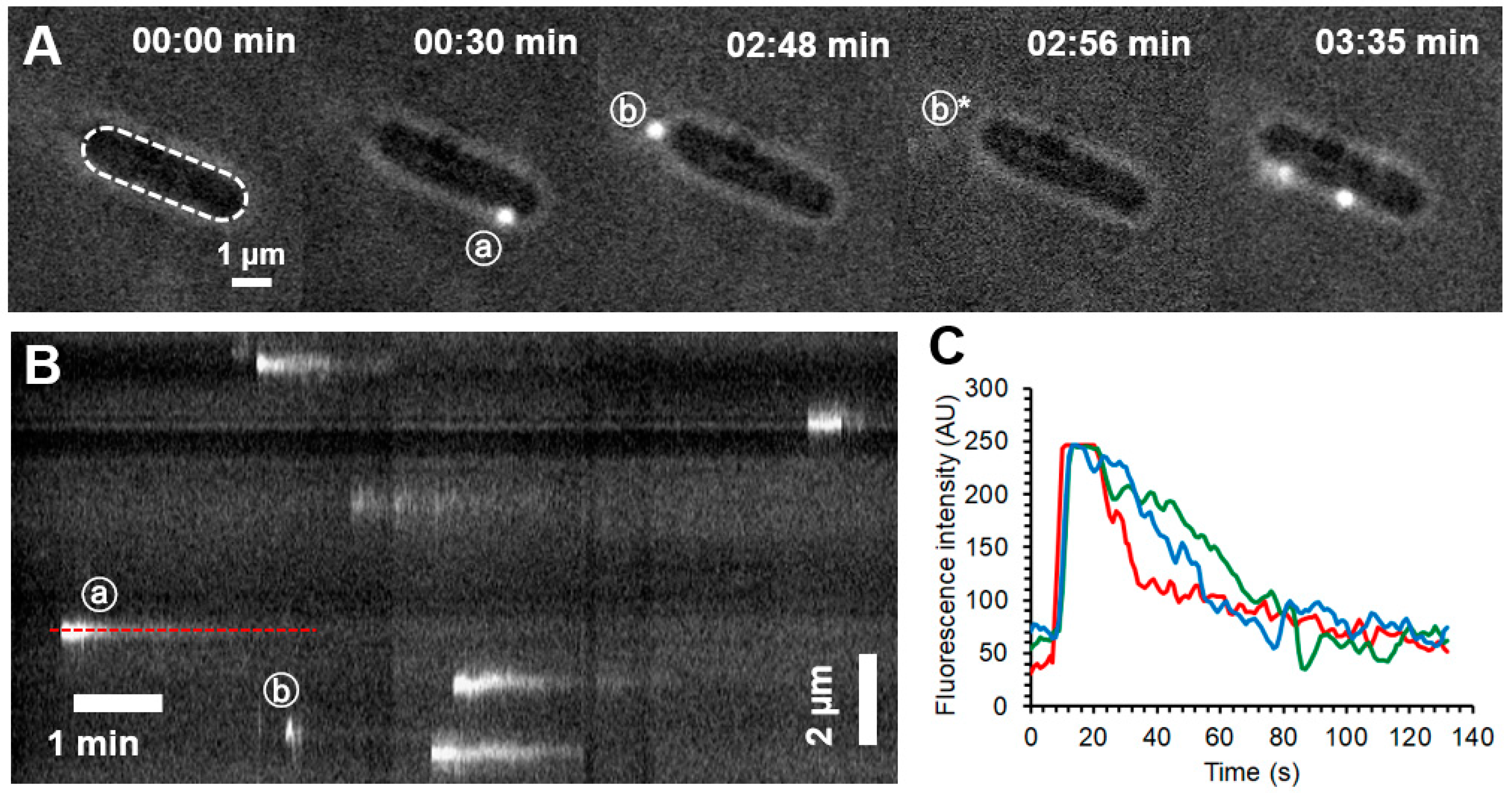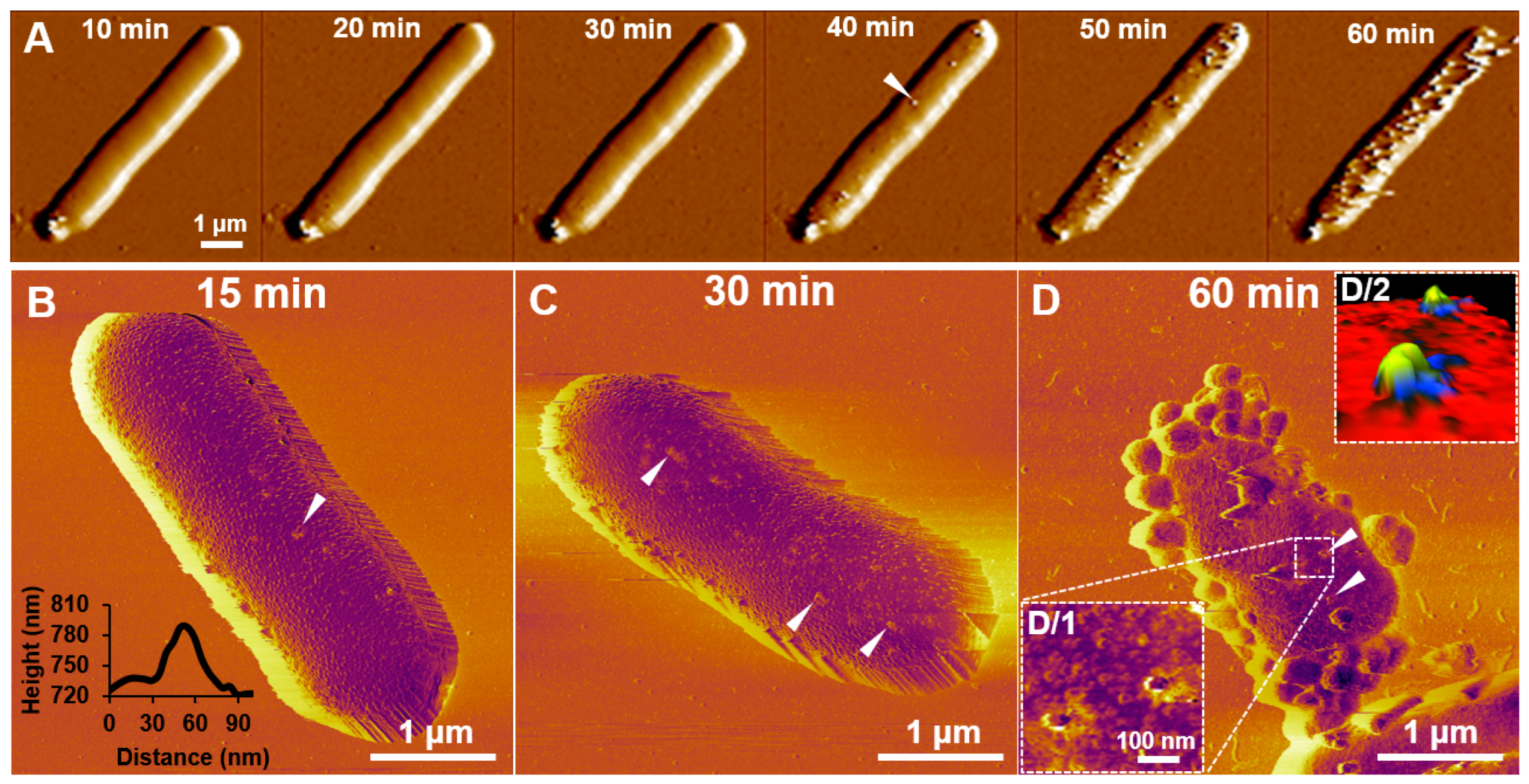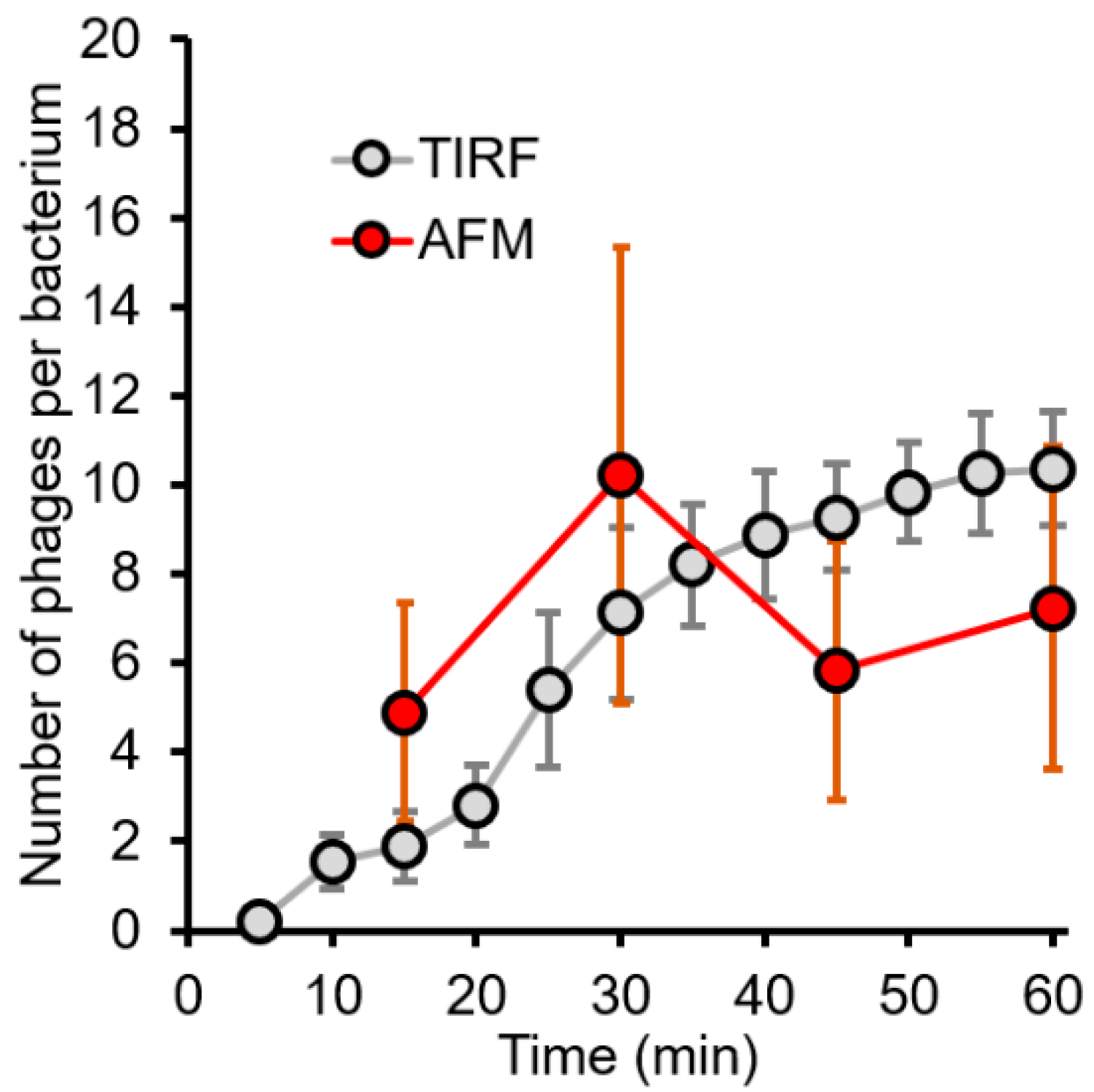Imaging the Infection Cycle of T7 at the Single Virion Level
Abstract
1. Introduction
2. Results
2.1. T7 Explores the E. coli Surface for Binding Site
2.2. Fate of Docked T7 and Its Genome
2.3. DNA Ejection Can Be Induced by Photothermal Activation
2.4. Structural Dynamics of the Infected Host Cell Surface
2.5. T7 Infection Induces E. coli Blebbing and Leads to a Violent Lysis
3. Discussion
3.1. T7 Explores the E. coli Surface for Binding Site
3.2. Fate of Docked T7 and Its Genome
3.3. DNA Ejection Can Be Induced by Photothermal Activation
3.4. Structural Dynamics of the Infected Host Cell Surface
3.5. T7 Infection Induces E. coli Blebbing and Leads to a Violent Lysis
4. Materials and Methods
4.1. Chemicals
4.2. Bacterial Cell Growth and Purification
4.3. Surface Preparation and Modifications
4.4. Bacterial Cell Immobilization
4.5. Sample Fixation for High-Resolution AFM Imaging
4.6. TIRF Microscopy of Host Infection
4.7. Single-Phage DNA-Ejection Experiments
4.8. Two-Dimensionally Restricted Bead Movement Experiments
4.9. Viral Target Search Tracking
4.10. AFM Imaging and Analysis
4.11. Phase-Contrast Microscopy
5. Conclusions
Supplementary Materials
Author Contributions
Funding
Institutional Review Board Statement
Informed Consent Statement
Data Availability Statement
Acknowledgments
Conflicts of Interest
References
- Hemminga, M.A.; Vos, W.L.; Nazarov, P.V.; Koehorst, R.B.; Wolfs, C.J.; Spruijt, R.B.; Stopar, D. Viruses: Incredible nanomachines. New advances with filamentous phages. Eur. Biophys. J. 2010, 39, 541–550. [Google Scholar] [CrossRef] [PubMed]
- Varanda, C.M.; Felix, M.D.R.; Campos, M.D.; Patanita, M.; Materatski, P. Plant Viruses: From Targets to Tools for CRISPR. Viruses 2021, 13, 141. [Google Scholar] [CrossRef] [PubMed]
- Nick, J.A.; Dedrick, R.M.; Gray, A.L.; Vladar, E.K.; Smith, B.E.; Freeman, K.G.; Malcolm, K.C.; Epperson, L.E.; Hasan, N.A.; Hendrix, J.; et al. Host and pathogen response to bacteriophage engineered against Mycobacterium abscessus lung infection. Cell 2022, 185, 1860–1874.e1812. [Google Scholar] [CrossRef] [PubMed]
- Cuervo, A.; Fabrega-Ferrer, M.; Machon, C.; Conesa, J.J.; Fernandez, F.J.; Perez-Luque, R.; Perez-Ruiz, M.; Pous, J.; Vega, M.C.; Carrascosa, J.L.; et al. Structures of T7 bacteriophage portal and tail suggest a viral DNA retention and ejection mechanism. Nat. Commun. 2019, 10, 3746. [Google Scholar] [CrossRef]
- Voros, Z.; Csik, G.; Herenyi, L.; Kellermayer, M. Temperature-Dependent Nanomechanics and Topography of Bacteriophage T7. J. Virol. 2018, 92, e01236-18. [Google Scholar] [CrossRef]
- Kellermayer, M.S.Z.; Voros, Z.; Csik, G.; Herenyi, L. Forced phage uncorking: Viral DNA ejection triggered by a mechanically sensitive switch. Nanoscale 2018, 10, 1898–1904. [Google Scholar] [CrossRef]
- Voros, Z.; Csik, G.; Herenyi, L.; Kellermayer, M.S. Stepwise reversible nanomechanical buckling in a viral capsid. Nanoscale 2017, 9, 1136–1143. [Google Scholar] [CrossRef]
- Kemp, P.; Gupta, M.; Molineux, I.J. Bacteriophage T7 DNA ejection into cells is initiated by an enzyme-like mechanism. Mol. Microbiol. 2004, 53, 1251–1265. [Google Scholar] [CrossRef]
- Molineux, I.J.; Panja, D. Popping the cork: Mechanisms of phage genome ejection. Nat. Rev. Microbiol. 2013, 11, 194–204. [Google Scholar] [CrossRef]
- Hu, B.; Margolin, W.; Molineux, I.J.; Liu, J. The bacteriophage t7 virion undergoes extensive structural remodeling during infection. Science 2013, 339, 576–579. [Google Scholar] [CrossRef]
- Molineux, I.J. No syringes please, ejection of phage T7 DNA from the virion is enzyme driven. Mol. Microbiol. 2001, 40, 1–8. [Google Scholar] [CrossRef] [PubMed]
- Mangenot, S.; Hochrein, M.; Radler, J.; Letellier, L. Real-time imaging of DNA ejection from single phage particles. Curr. Biol. 2005, 15, 430–435. [Google Scholar] [CrossRef] [PubMed]
- Grayson, P.; Han, L.; Winther, T.; Phillips, R. Real-time observations of single bacteriophage λ DNA ejections in vitro. Proc. Natl. Acad. Sci. USA 2007, 104, 14652. [Google Scholar] [CrossRef] [PubMed]
- Van Valen, D.; Wu, D.; Chen, Y.J.; Tuson, H.; Wiggins, P.; Phillips, R. A single-molecule Hershey-Chase experiment. Curr. Biol. 2012, 22, 1339–1343. [Google Scholar] [CrossRef]
- Smith, D.E.; Tans, S.J.; Smith, S.B.; Grimes, S.; Anderson, D.L.; Bustamante, C. The bacteriophage φ29 portal motor can package DNA against a large internal force. Nature 2001, 413, 748. [Google Scholar] [CrossRef]
- Young, R. Phage lysis: Three steps, three choices, one outcome. J. Microbiol. 2014, 52, 243–258. [Google Scholar] [CrossRef]
- Summer, E.J.; Berry, J.; Tran, T.A.; Niu, L.; Struck, D.K.; Young, R. Rz/Rz1 lysis gene equivalents in phages of Gram-negative hosts. J. Mol. Biol. 2007, 373, 1098–1112. [Google Scholar] [CrossRef]
- Mandal, P.K.; Ballerin, G.; Nolan, L.M.; Petty, N.K.; Whitchurch, C.B. Bacteriophage infection of Escherichia coli leads to the formation of membrane vesicles via both explosive cell lysis and membrane blebbing. Microbiology 2021, 167, 001021. [Google Scholar] [CrossRef]
- Kutter, E.; Sulakvelidze, A. Bacteriophages: Biology and Applications; CRC Press: Boca Raton, FL, USA, 2004. [Google Scholar] [CrossRef]
- Kiss, B.; Mudra, D.; Torok, G.; Martonfalvi, Z.; Csik, G.; Herenyi, L.; Kellermayer, M. Single-particle virology. Biophys. Rev. 2020, 12, 1141–1154. [Google Scholar] [CrossRef]
- Shabram, P.; Aguilar-Cordova, E. Multiplicity of infection/multiplicity of confusion. Mol. Ther. 2000, 2, 420–421. [Google Scholar] [CrossRef]
- Kemp, P.; Garcia, L.R.; Molineux, I.J. Changes in bacteriophage T7 virion structure at the initiation of infection. Virology 2005, 340, 307–317. [Google Scholar] [CrossRef] [PubMed]
- Ivanovska, I.; Wuite, G.; Jonsson, B.; Evilevitch, A. Internal DNA pressure modifies stability of WT phage. Proc. Natl. Acad. Sci. USA 2007, 104, 9603–9608. [Google Scholar] [CrossRef] [PubMed]
- Chang, C.Y.; Kemp, P.; Molineux, I.J. Gp15 and gp16 cooperate in translocating bacteriophage T7 DNA into the infected cell. Virology 2010, 398, 176–186. [Google Scholar] [CrossRef] [PubMed]
- Dunn, J.J.; Studier, F.W. Complete nucleotide sequence of bacteriophage T7 DNA and the locations of T7 genetic elements. J. Mol. Biol. 1983, 166, 477–535. [Google Scholar] [CrossRef]
- MacDonald, I.A.; Kuehn, M.J. Offense and defense: Microbial membrane vesicles play both ways. Res. Microbiol. 2012, 163, 607–618. [Google Scholar] [CrossRef]
- Wong, F.; Amir, A. Mechanics and Dynamics of Bacterial Cell Lysis. Biophys. J. 2019, 116, 2378–2389. [Google Scholar] [CrossRef]
- Young, R. Bacteriophage lysis: Mechanism and regulation. Microbiol. Rev. 1992, 56, 430–481. [Google Scholar] [CrossRef]
- Center, M.S.; Studier, F.W.; Richardson, C.C. The structural gene for a T7 endonuclease essential for phage DNA synthesis. Proc. Natl. Acad. Sci. USA 1970, 65, 242–248. [Google Scholar] [CrossRef]
- Gábor, F.; Szolnoki, J.; Tóth, K.; Fekete, A.; Maillard, P.; Csík, G. Photoinduced Inactivation of T7 Phage Sensitized by Symmetrically and Asymmetrically Substituted Tetraphenyl Porphyrin: Comparison of Efficiency and Mechanism of Action. Photochem. Photobiol. 2001, 73, 304–311. [Google Scholar] [CrossRef]
- Biebricher, A.S.; Heller, I.; Roijmans, R.F.; Hoekstra, T.P.; Peterman, E.J.; Wuite, G.J. The impact of DNA intercalators on DNA and DNA-processing enzymes elucidated through force-dependent binding kinetics. Nat. Commun. 2015, 6, 7304. [Google Scholar] [CrossRef]
- Huang, C.; Becker, M.F.; Keto, J.W.; Kovar, D. Annealing of nanostructured silver films produced by supersonic deposition of nanoparticles. J. Appl. Phys. 2007, 102, 054308. [Google Scholar] [CrossRef]
- Tinevez, J.Y.; Perry, N.; Schindelin, J.; Hoopes, G.M.; Reynolds, G.D.; Laplantine, E.; Bednarek, S.Y.; Shorte, S.L.; Eliceiri, K.W. TrackMate: An open and extensible platform for single-particle tracking. Methods 2017, 115, 80–90. [Google Scholar] [CrossRef] [PubMed]
- Richter, V.; Lanzerstorfer, P.; Weghuber, J.; Schneckenburger, H. Super-Resolution Live Cell Microscopy of Membrane-Proximal Fluorophores. Int. J. Mol. Sci. 2020, 21, 7099. [Google Scholar] [CrossRef] [PubMed]
- Marcuello, C.; de Miguel, R.; Lostao, A. Molecular Recognition of Proteins through Quantitative Force Maps at Single Molecule Level. Biomolecules 2022, 12, 594. [Google Scholar] [CrossRef]







Publisher’s Note: MDPI stays neutral with regard to jurisdictional claims in published maps and institutional affiliations. |
© 2022 by the authors. Licensee MDPI, Basel, Switzerland. This article is an open access article distributed under the terms and conditions of the Creative Commons Attribution (CC BY) license (https://creativecommons.org/licenses/by/4.0/).
Share and Cite
Kiss, B.; Kiss, L.A.; Lohinai, Z.D.; Mudra, D.; Tordai, H.; Herenyi, L.; Csík, G.; Kellermayer, M. Imaging the Infection Cycle of T7 at the Single Virion Level. Int. J. Mol. Sci. 2022, 23, 11252. https://doi.org/10.3390/ijms231911252
Kiss B, Kiss LA, Lohinai ZD, Mudra D, Tordai H, Herenyi L, Csík G, Kellermayer M. Imaging the Infection Cycle of T7 at the Single Virion Level. International Journal of Molecular Sciences. 2022; 23(19):11252. https://doi.org/10.3390/ijms231911252
Chicago/Turabian StyleKiss, Bálint, Luca Annamária Kiss, Zsombor Dávid Lohinai, Dorottya Mudra, Hedvig Tordai, Levente Herenyi, Gabriella Csík, and Miklós Kellermayer. 2022. "Imaging the Infection Cycle of T7 at the Single Virion Level" International Journal of Molecular Sciences 23, no. 19: 11252. https://doi.org/10.3390/ijms231911252
APA StyleKiss, B., Kiss, L. A., Lohinai, Z. D., Mudra, D., Tordai, H., Herenyi, L., Csík, G., & Kellermayer, M. (2022). Imaging the Infection Cycle of T7 at the Single Virion Level. International Journal of Molecular Sciences, 23(19), 11252. https://doi.org/10.3390/ijms231911252




